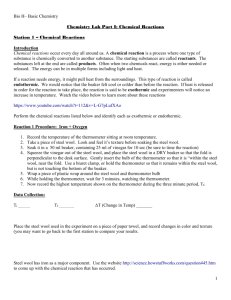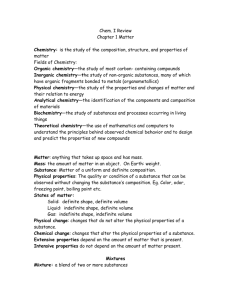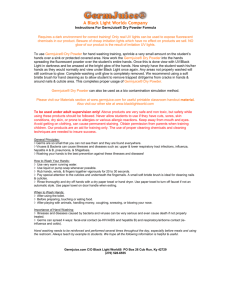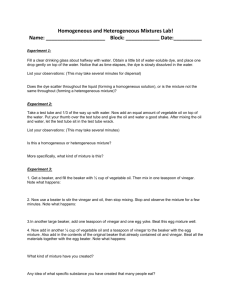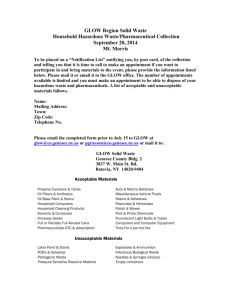Station 1 – Chemical Reactions
advertisement
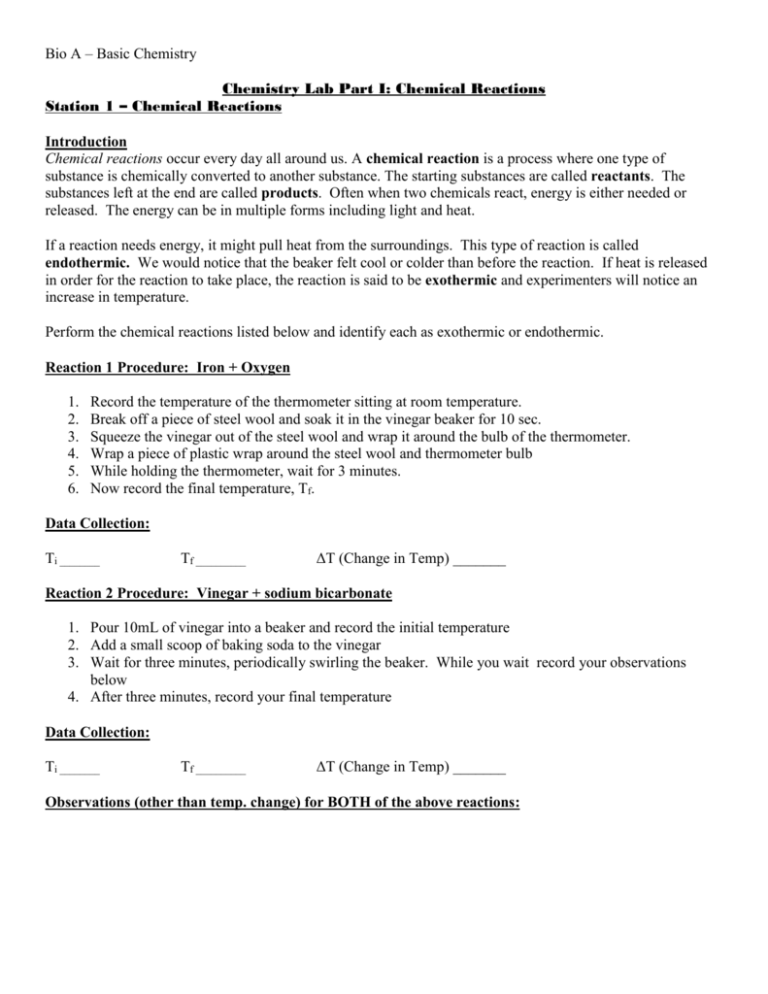
Bio A – Basic Chemistry Chemistry Lab Part I: Chemical Reactions Station 1 – Chemical Reactions Introduction Chemical reactions occur every day all around us. A chemical reaction is a process where one type of substance is chemically converted to another substance. The starting substances are called reactants. The substances left at the end are called products. Often when two chemicals react, energy is either needed or released. The energy can be in multiple forms including light and heat. If a reaction needs energy, it might pull heat from the surroundings. This type of reaction is called endothermic. We would notice that the beaker felt cool or colder than before the reaction. If heat is released in order for the reaction to take place, the reaction is said to be exothermic and experimenters will notice an increase in temperature. Perform the chemical reactions listed below and identify each as exothermic or endothermic. Reaction 1 Procedure: Iron + Oxygen 1. 2. 3. 4. 5. 6. Record the temperature of the thermometer sitting at room temperature. Break off a piece of steel wool and soak it in the vinegar beaker for 10 sec. Squeeze the vinegar out of the steel wool and wrap it around the bulb of the thermometer. Wrap a piece of plastic wrap around the steel wool and thermometer bulb While holding the thermometer, wait for 3 minutes. Now record the final temperature, Tf. Data Collection: Ti ________ Tf __________ ΔT (Change in Temp) _______ Reaction 2 Procedure: Vinegar + sodium bicarbonate 1. Pour 10mL of vinegar into a beaker and record the initial temperature 2. Add a small scoop of baking soda to the vinegar 3. Wait for three minutes, periodically swirling the beaker. While you wait record your observations below 4. After three minutes, record your final temperature Data Collection: Ti ________ Tf __________ ΔT (Change in Temp) _______ Observations (other than temp. change) for BOTH of the above reactions: Bio A – Basic Chemistry Station 2 – Types of Mixtures Introduction: A is two or more pure substances, combined in varying proportions - each retaining its own specific properties. The components of a can be separated by physical means, i.e. without making or breaking of chemical bonds. A homogeneous mixture has the same uniform appearance and composition throughout. Homogeneous mixtures are also called solutions. The powder is called the solute, the liquid is called the solvent. A heterogeneous mixture consists of visibly different substances or phases. These may also be called suspensions. The two substances might not be obvious right after shaking the mixture. But if a suspension is allowed to sit for a while, the substances will separate. This will not happen with a solution. Procedure: Put 50mL of water into each of two beakers. You have been given several grams of two different powders. - Very carefully, place a small scoop of powder A into one of the beakers of water. - Place a similar amount of powder B into the OTHER beaker of water. - Stir each mixture with the stirring rod and observe what happens. Allow each to sit for a minute or two. Record whether you saw any powder settle. Identify which mixture (A or B) is a solution and which is a suspension. Data Collection: Observations for Powder A in water: ________________________________________________________________________ ________________________________________________________________________ Observations for Powder B in water: ________________________________________________________________________ ________________________________________________________________________ Bio A – Basic Chemistry Station 3 – Fluorescence In the beginning of lab we said that chemical reactions can give off energy. Other chemicals actually absorb energy and then give it back out in the form of light. For instance, a lot of chemicals can absorb UV light, which we can not see, and give off visible light creating a sort of “glow” call fluorescence. In this part of the lab we are going to test some materials to determine which have the ability to absorb UV and emit visible light. Procedure: 1. 2. 3. 4. 5. Check this lab station for the substances that you will be testing. Record each in the table below. One at a time, place each substance in the box and allow it to sit for 15 seconds while you observe Record whether the substance “glows” or any other important observations Repeat with each of the substances. Remove everything from the box and turn off the light. Are there any other observations you’d like to record? (hint hint….) Data: Substance Observations HC2H3O2 Bio A – Basic Chemistry Station 4 – Temperature affects Chemistry How quickly a chemical reaction takes place depends on several things: the amount of the reactants, the presence or absence of a catalyst (something that speeds up a reaction without changing itself) and even the temperature. In this easy little experiment we are going to compare a chemical reaction at three different temperatures and see which works the best. Procedure: NOTE: Do not touch the hot plate or adjust the dials for any reason!!! - You may need to add more ice if the ice water has all melted 1. 2. 3. 4. 5. 6. 7. You have three beakers in front of you: Ice water, Room temp water and hot water. Begin by placing the glow stick in the room temp beaker. After you have observe it for a bit, move it to the hot water beaker. Record any changes. Now place the glow stick in the ice water bath Record any changes Before moving to the next station, return the glow stick to the room temp beaker. Data: What did you notice about the three different light sticks? Bio A – Basic Chemistry Lab Questions: Directions: use the information in this lab AND YOUR NOTES to answer the following lab questions. DON’T GUESS. You have the info to answer accurately; it might just take a little work. Questions for Station 1: 1. Reactants and products: a. What is the product of reaction 1? b. What are the reactants of reaction 2? 2. Endothermic/Exothermic: a. Which reaction is endothermic? How do you know? b. Which reaction is exothermic? How do you know? Questions for Station 2: Powder A = corn starch Powder B = confectioners sugar 1. What was the solvent for mixture B? 2. What was the solute for mixture B? 3. Which powder formed a solution? How do you know? 4. What term do we use to describe the mixture that didn’t form a solution? Questions for Station 3: 1. List all the substances that contained fluorescent molecules: 2. Tide is trying to scam its customers! It makes clothes look like they “glow” under UV light. a. What is the most common source of everyday UV light? b. Tide wants people to think that the brightness of the “glowing” clothes means that the clothes are actually _______________________. Bio A – Basic Chemistry 3. What effect did the UV light have on the white beads? Questions for Station 4: 1. What happened to the glow stick when you put it in cold water? Why? 2. What happened to the glow stick in the hot water? Why? CONCLUSION QUESTION: this will require some thinking and explaining, but you can do it! Ok. Here is what we’ve learned: 1. When certain chemicals are mixed, a chemical reaction happens 2. Chemical reactions can release energy. 3. Fluorescent chemicals can absorb energy and turn it into light 4. A “dead” glow stick will glow again if it absorbs energy from UV light. 5. Chemical reactions only last for however long there are reactants. Once all the reactants have been converted to products, the reaction ends. 6. Heat will speed up how fast reactants become products. Cold will slow down the conversion from reactant to product. With the above info and your brains do the following: 1. Explain how a glow stick works (no need for chemical names, but you should mention all the parts that are necessary) to make it easier, put it in a bulleted list so you can answer step by step. 2. Explain why putting your glow stick in the freezer can extend its “life” after it is cracked.

